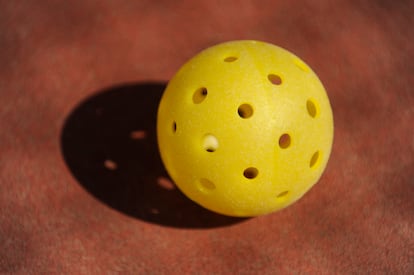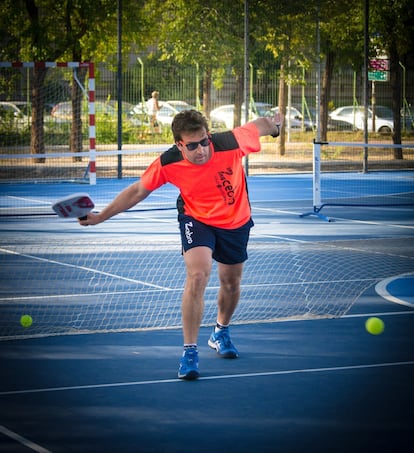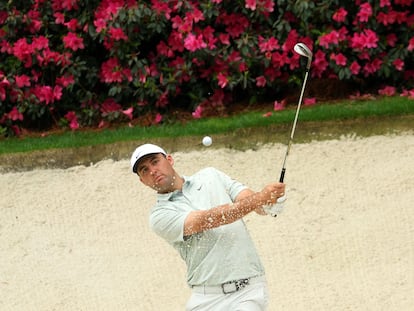Pickleball, the next big thing in sports
A cross of tennis, ping-pong and badminton, it is the fastest-growing sport in America, with around five million players. Several experts explain the reasons behind its success

Like so many others in the last couple of years, the life of Xiana Lopez took a radical turn after the Covid-19 pandemic. A news director for La Sexta, a Spanish free-to-air television channel, Lopez continued getting up at 4.30am during the worst moments of the health crisis, only to find herself surrounded by fake news and worrying reports. This prompted her to think about creating a different future for her family. “I made up my mind that if a new pandemic came, I would be in Hawaii, working remotely from there,” she says. “And I usually chase what I set out to do.” That desire translated into different courses on international trade, how to be an Amazon seller, and extensive market research on what kind of product could satisfy her entrepreneurial impulse. While driving the A-7 highway, she noticed a sign inviting her to try a sport previously unknown in Spain: pickleball.
Pickleball was invented in 1965 by a US senator looking for an entertaining way to spend a summer afternoon with friends. Reportedly named after the senator’s dog, Pickles, the game is a quirky mix of tennis, ping-pong and badminton. In the United States, interest in the sport has risen dramatically over the past few years. There are now 4.8 million players in the US, a rise of 650% over the past six years. Pickleball is usually played in doubles format on courts of a similar size to a doubles badminton court, and the player who reaches 11 points first wins the set. It’s inexpensive – players only need a paddle, a ball, a net and a smooth surface to play on –, easy to learn and can be played by the entire family.
“We are in a lovely moment because more and more people want to try it,” says Daniel Hernando, the head of the sport’s brand new Spanish federation. “We are being contacted by many companies who are attracted to the sport for economic reasons. We can put up to four pickleball courts in a tennis court.” Hernando has been lobbying for the sport in Spain for nearly a decade – work that has started to pay off. “We are already close to 1,000 players. Although we still have a long way to go to match the Americans, we are at a high level in Europe, achieving amazing results,” he says.

If there is a figure in today’s pickleball in Spain comparable to tennis pioneers such as Manolo Santana: it would be Ernesto Cardenas. This 41-year-old physical education teacher is the most important Spanish player in the sport. He has participated in tournaments in the Netherlands, Germany, Italy, and a large part of the West Coast of the US. “I discovered the discipline through an education program when I moved to Utah in 2014. I was looking for people to play paddle-ball with and make friends, but hardly anyone knew of it because they all preferred pickleball.” He continues: “When I returned to Spain, I browsed online for people to continue playing and we began promoting it around the country.” Initially, Cardenas had to cover all the expenses out of his own pocket, such as travel, equipment and accommodation, but today he has sponsorship deals. “My friends and family understand that it’s my life philosophy, but you still can’t be a professional pickleball player in Spain,” he says.
One of Cardenas’ sponsors is ZCebra, the company created by Xiana Lopez when she was looking for change. This business is the first exclusive manufacturer of pickleball products in Europe. “There were no brands manufacturing and distributing gear throughout the continent, so it was clear to me what I had to do. I left my permanent contract at La Sexta and invested my life savings. Now we manufacture everything a person needs to play,” explains Lopez. According to the entrepreneur, sales have increased 50% in the last six months. But she thinks the big breakthrough is still to come. “I believe that in a decade, pickleball will surpass paddle-ball in Spain because it’s cheap, accessible, simple and anyone can play. It’s already being implemented in schools, sports clubs, fire stations, prisons and centers for people with disabilities,” she says. The perception of her new line of work has also changed: “They called me crazy when I left my job, but now they call me a visionary. I’m not, but I knew that Spain always runs a little bit behind the trend, but gets there in the end.”
According to the US Pickleball Association, in the US, pickleball has seen a 39.9% growth rate of players. The best pickleball players already have dozens of sponsors, the sports channel ESPN now owns the rights to its most prestigious tournaments, and prizes are already well over five figures. Some games have more than a million views on YouTube. Restrictions due to the coronavirus health crisis also boosted these numbers. “Last March, when quarantines went into effect and gyms closed, portable pickleball nets temporarily sold out. Players set up courts, which are half the size of tennis courts, in driveways,” The Economist reported.
For the sport to see the same success in Spain, Hernando says more courts are needed. “We need our own fixed facilities. In Madrid, for example, we only have about 20 specific pickleball courts in three sports centers.” Lopez agrees: “That’s all it takes to make it happen.” Having introduced the sport to his students as a teaching unit, Cardenas is also optimistic about the future: “We are currently in a pop-up format: we set up the nets and play… If we have more places and courts, people from paddle-ball and tennis will be hooked.”
Tu suscripción se está usando en otro dispositivo
¿Quieres añadir otro usuario a tu suscripción?
Si continúas leyendo en este dispositivo, no se podrá leer en el otro.
FlechaTu suscripción se está usando en otro dispositivo y solo puedes acceder a EL PAÍS desde un dispositivo a la vez.
Si quieres compartir tu cuenta, cambia tu suscripción a la modalidad Premium, así podrás añadir otro usuario. Cada uno accederá con su propia cuenta de email, lo que os permitirá personalizar vuestra experiencia en EL PAÍS.
¿Tienes una suscripción de empresa? Accede aquí para contratar más cuentas.
En el caso de no saber quién está usando tu cuenta, te recomendamos cambiar tu contraseña aquí.
Si decides continuar compartiendo tu cuenta, este mensaje se mostrará en tu dispositivo y en el de la otra persona que está usando tu cuenta de forma indefinida, afectando a tu experiencia de lectura. Puedes consultar aquí los términos y condiciones de la suscripción digital.
More information
Últimas noticias
Most viewed
- Alain Aspect, Nobel laureate in physics: ‘Einstein was so smart that he would have had to recognize quantum entanglement’
- Mexico’s missing people crisis casts a shadow over World Cup venue
- Why oil has been at the center of Venezuela-US conflicts for decades
- Trump clarifies who is ultimately in charge in Venezuela: ‘Me’
- Mexico seeks to shore up its defenses following US incursion in Venezuela










































